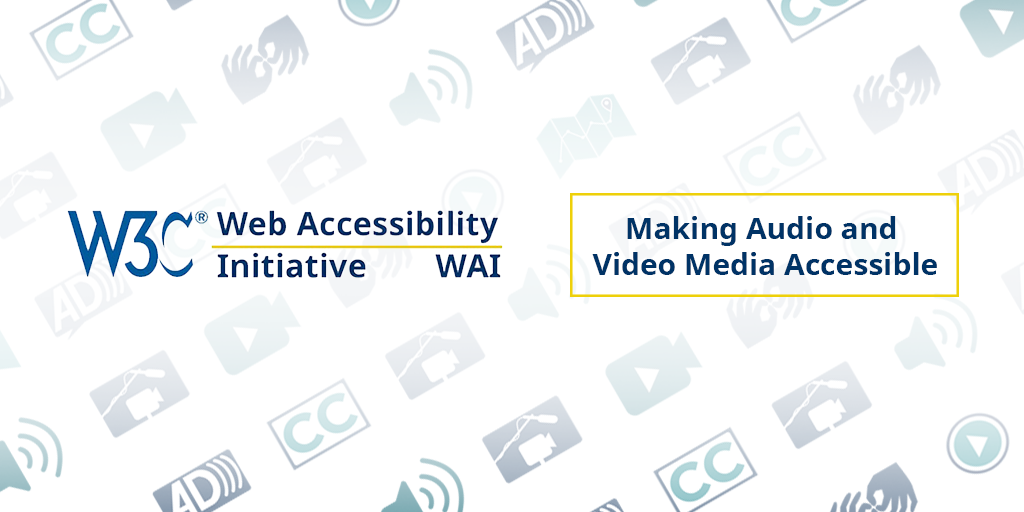Current Work
(updated monthly)
See What We're Working On – Accessibility Activities and Publications
WCAG 2.2 Approved as an ISO Standard
(2025-Oct-21)
Web Content Accessibility Guidelines (WCAG) 2.2 is now an approved International Organization for Standardization (ISO) standard: ISO/IEC 40500:2025. It is available free from ISO/IEC 40500:2025 - Information technology — W3C Web Content Accessibility Guidelines (WCAG) 2.2. This standard enables more countries to formally adopt WCAG 2.2. Additional information is in the W3C press release on WCAG 2.2 approved as ISO/IEC international standard and ‘ISO/IEC 40500, EAA, EN 301 549’ section of WCAG 2 Overview.
For Review: WCAG 3 Working Draft - September 2025
(2025-Sep-04)
W3C Accessibility Guidelines (WCAG) 3.0 Working Draft is updated. For review questions and how to comment, please see the WCAG 3 section ‘About this draft’. The starting place for background, timeline, and up-to-date information is the WCAG 3 Introduction.
For Wide Review: Accessibility Maturity Model — Updated Draft Note
(2025-Sep-01)
Accessibility Maturity Model Updated Draft Note is ready for review. The Accessibility Maturity Model provides a framework to assess an organization’s policies and procedures to deliver accessible products and services. It can be used to measure current capabilities, identify gaps, and plan improvements. For more details, review questions and how to comment, see the email announcing the Accessibility Maturity Model update. Please comment by 30 September 2025.
WCAG2ICT — W3C Group Note updated to coordinate with EN 301 549
(2025-Aug-21)
Guidance on Applying WCAG 2 to Non-Web Information and Communications Technologies (WCAG2ICT) has been updated in coordination with the work to update EN 301 549. EN 301 549 is the European standard ‘Accessibility requirements for ICT products and services’. For the list of substantive changes, see Changes since the 15 November 2024 Note. For an introduction to WCAG2ICT, see the WCAG2ICT Overview.
Call for implementations: Accessibility Conformance Testing (ACT) Rules Format 1.1 — Candidate Recommendation
(2025-Aug-19)
Accessibility Conformance Testing (ACT) Rules Format 1.1 is now a Candidate Recommendation Snapshot. That means we’re seeking example implementations. ACT Rules Format defines a format for writing accessibility test rules that can be used for developing automated testing tools and manual testing methodologies. For an introduction to Accessibility Conformance Testing, see the ACT Overview. We welcome implementations any time. Please submit any comments by 20 October 2025.
Advancing Digital Accessibility with W3C WAI — keynote recording available
(2025-Jul-24)
Shawn Lawton Henry (Director, Web Accessibility Initiative (WAI)) and Kevin White (Senior Principal Accessibility Specialist) led an interactive session at the AccessU 2025 training conference. Learn about WAI resources to help promote that accessibility is about improving the user experiences of people with disabilities, and to support you in planning, managing, designing, developing, and training for digital accessibility. The Q&A includes the WCAG 3 approach and timeline (years away). Find out how you can contribute to W3C accessibility work. See the recording of Advancing Digital Accessibility with W3C WAI.
DPUB-ARIA and DPUB-AAM are now Web Standards (W3C Recommendations)
(2025-Jun-12)
Digital Publishing WAI-ARIA Module 1.1 (DPUB-ARIA) and Digital Publishing Accessibility API Mappings 1.1 (DPUB-AAM) are now web standards (W3C Recommendations). DPUB-ARIA defines a set of ARIA roles to help assistive technology users navigate structural divisions of long-form digital documents, such as eBooks. DPUB-AAM defines how user agents (such as eBook readers) map the DPUB-ARIA markup to platform accessibility APIs. For an introduction to WAI-ARIA, see WAI-ARIA Overview.
See All News Subscribe to WAI News

